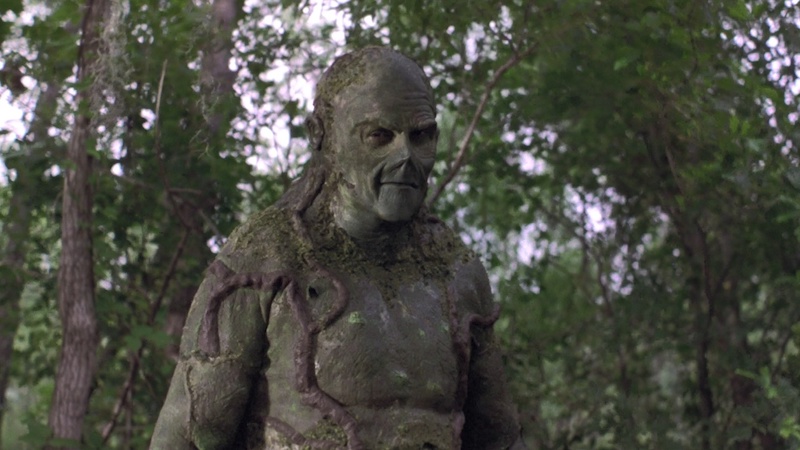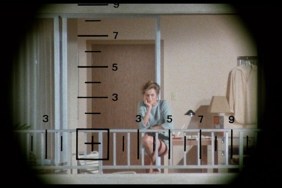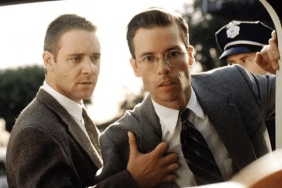Swamp Thing is an incredible character that helped set new standards for horror comics, created by Len Wein and Bernie Wrightson in 1971, and someone who completely deserved to get his own feature film. Having it written and directed by Wes Craven, one of the masters of horror, as well as the music composed by Harry Manfredini, who scored most of the Friday the 13th films, all sounds like a brilliant idea for creating a classic horror spectacle – which it wasn’t. Even though all of the pieces seemed to be in place for a solid project, looking back at the Swamp Thing film as it celebrates 40 years of life, shines some sunlight on just how un-evergreen it is.
Released in 1982, the movie sees scientist Alec Holland’s (Ray Wise) new breakthrough formula turn him into a plant creature, after an evil paramilitary group led by Anton Arcane (Louis Jourdan) steals his research, kills his sister, and lets Holland set himself on fire. Fleeing to the swamp to put out the flames while covered in his chemical concoction, Holland becomes one with the area around him and emerges as Swamp Thing (Dick Durock). Alice Cable (Adrienne Barbeau), a merger of Matt Cable and Abby Arcane from the comics, witnesses these events and attempts to keep Arcane from getting his hands on the last set of notes he needs to replicate the formula, which involves her being captured a lot and Swamp Thing saving her. She’s accompanied by Jude (Reggie Batts), a local kid who gets mixed up in the action as battles rage across the bayou.
The characters are not the problem here, as the main cast all perform admirably, even if the dialog isn’t always on their side and the script makes them look incompetent or out of place. Poor Cable goes from badass to tripping over herself twice – to the point that Craven’s daughter commented negatively on this – and being captured multiple times. Jude seems like he’ll be the annoying kid sidekick for her, but he comes off much better after things get rolling, and he has some of the best lines in the film. Anton Arcane is an excellent name for an advisory and although he comes across more like a Bond villain in some scenes (which the actor would go on to play next), his detached personality and intensity bring needed gravity to the role.
A large amount of what made Swamp Thing not work is in its visual presentation. Though the film would be shot on location in South Carolina with some of the action scenes being done later near L.A., many portions of the movie still look cheap. It’s an accurate statement, as the film’s budget was around $2.5 million and Craven made sure that this wasn’t exceeded, focusing on getting the film out.
The costume in particular looked bad, appearing like an obvious rubber suit, even though it resembled the comic book version of the character decently and tried for a more detailed face. The material ripped during filming and the hostile environment caused some parts to degrade, forcing the crew to improvise. Much of the action is shot during the day, which fits with the story, but makes it harder to hide imperfections and obscure the character. The creature is shown too much for its own good and lumbers awkwardly at times. Many of the effects for his powers aren’t interesting, some continuity errors make certain blemishes stick out more – like where he heals Cable and it somehow also cleans the blood off of her shirt – and there are some cheesy scene wipes on top of everything else.
It also doesn’t help that this is a 91-minute film that feels like it’s much longer. Swamp Thing has a slower start with some solid buildup at points, but it somehow never found much time for real character development. These pacing issues aren’t helped by the fact that the lead-up to the big monster brawl at the end is rushed, and even though it’s exciting to see Swamp Thing finally unleashed, the fight is pretty lackluster overall. There is also the odd aggressive pairing of Holland and Cable, who just met, but have one of the worst love stories for a movie like this. It was a focus though, as one of the poster taglines even read, “Science transformed him into a monster. Love changed him even more.” Okay, movie, sure, but explain that creepy part where Swamp Thing is watching Cable bathe topless, please?
Looking behind the scenes makes the film sound worse, as it was plagued with issues during production. South Carolina’s environment was a big problem for one, where extreme heat forced Durock and Ben Bates, the men in the monster suits, to take frequent breaks, and the latter to even pass out at one point. The animals were also a problem, with various snakes, alligators, and an infestation of black caterpillars that would fall from trees and bite the crew constantly. The conditions on set supposedly led to workers using hard drugs in between takes to help cope.
Sadly, Louis Jourdan’s son died during filming, but the actor stayed on the project and threw himself into the work even more. On the financial side, the bond company that provided the money for the movie was also quite tough to deal with, according to Craven. They not only slashed the budget but also pushed the director to overwork the crew to stay on schedule. This is also why several scenes in the film were cut, like the tunnel chase that would have helped build the tension and excitement leading into the final confrontation with Arcane.
It’s kind of amazing that their creation even saw the light of day considering everything that happened.
Swamp Thing wasn’t given a large marketing budget, used mostly for posters and print ads. It didn’t perform well in the box office but picked up popularity with a VHS release and being aired on television. There were two cuts of the film, an overseas release meant for the UK that had two minutes of extra footage in it, containing extra nudity, which was the version accidentally printed for the US DVDs. This release claimed the movie was rated PG. After some angry parents complained to Blockbuster, these had to be recalled and redistributed.
The film did receive a comic book adaptation for Swamp Thing Annual #1 (1982), a sequel movie, The Return of Swamp Thing (1989), which was campier but with a better costume and pacing, as well as a short-lived slightly ridiculous cartoon that only lasted five episodes. Most of the people who worked on the film went on to have excellent careers, even though it didn’t feel like that at the time – especially for Director Wes Craven who did the film to prove himself, but wouldn’t work for the next two years. During the filming of this, however, is where he would develop the idea for A Nightmare on Elm Street.
Roger Ebert said in his review, “There’s beauty in this movie, if you know where to look for it.” That’s a true statement, but it requires the viewer to be accepting and know what they are getting into also. It’s easy to see this charm in the film, especially knowing more about what it took to bring Swamp Thing to life, like an eager puppy you want to pat on the head. Take a look back 40 years and see how far superhero movies have come, because growth has to begin somewhere, and we owe Swamp Thing for that at least.










